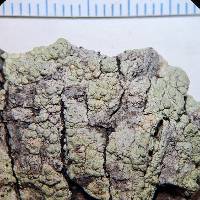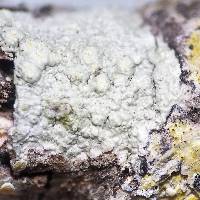
Consortium of Lichen Herbaria
- building a Global Consortium of Bryophytes and Lichens as keystones of cryptobiotic communities -
- Home
- Search
- Images
- Species Checklists
- US States: O-Z >
- US National Parks
- Central America
- South America
- US National Parks
- Southern Subpolar Region
|
|
|
|
Family: Pertusariaceae
Texas Wart Lichen
[Pertusaria disticha Erichsen] |
Nash, T.H., Ryan, B.D., Gries, C., Bungartz, F., (eds.) 2002. Lichen Flora of the Greater Sonoran Desert Region. Vol 1. Thallus: continuous to finely fissured, with thin to moderately thick verrucae; margins: entire, unzoned upper surface: green-gray to yellow-gray or yellow-green, dull or shiny, smooth to tuberculate, shiny, epruinose; lacking soredia or isidia fertile verrucae: concolorous with thallus, ampliariate to erect, conical to flat-topped, numerous, c. 0.5-2.0 mm in diam.; ostioles: 1-6 per verruca, hyaline to brownish, surrounded by a yellow border, level to papillate Apothecia: 1-5 per verruca; epithecium: hyaline to black, K- or + weakly violet; hypothecium: yellowish to yellow-brown asci: clavate, 210-400 x 32-65 µm, mostly 8-spored ascospores: hyaline, ellipsoid to fusiform, 35-88 x 19-44 µm; spore wall: 2-layered; outer spore wall c. 1-5 µm thick; inner spore wall: 2-8 µm thick, smooth; apices; up to 24 µm thick Pycnidia: not seen Spot tests: K+ yellow, C+ orange, KC-, P+ yellow to orange, UV+ orange-red Secondary metabolites: stictic and thiophaninic acids (both major), constictic acid, 2-chloro-6-O-methylnorlichexanthone, and 4-chloro-6-O-methylnorlichexanthone (all minor). Substrate and ecology: on bark including Acacia, Jatropha, and Quercus World distribution: North and Central America Sonoran distribution: coastal and mountainous areas of Baja California Sur, Sonora and Sinaloa at different elevations of 100-1200 m. Notes: Pertusaria texana is characterized by a yellowish thallus with poriform apothecia, often warted verrucae and small ostioles with yellow papillae at the top, 8-spored asci, ascospores with smooth walls, and the production of thiophaninic and stictic acids. Morphologically it is difficult to separate the species from the largely sympatric P. xanthodes which shares the same chemosyndromes, but is distinguished in having hyaline ostioles, 2-spored asci and rough-walled ascospores. |
|
|
|
Powered by Symbiota












































































































